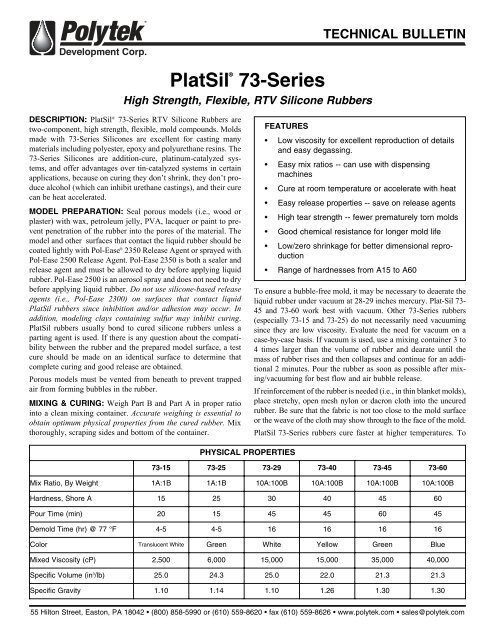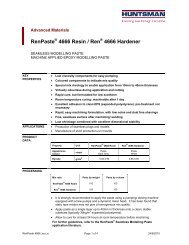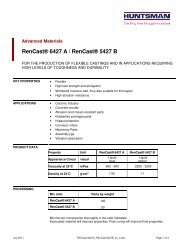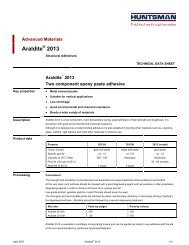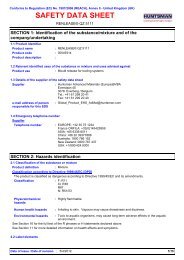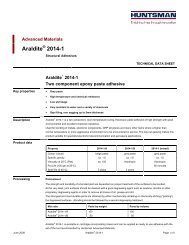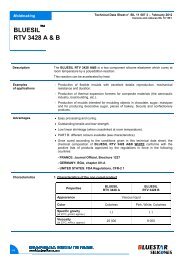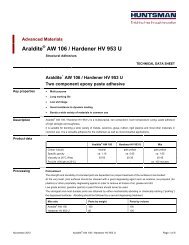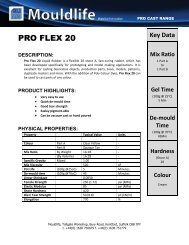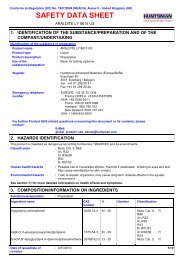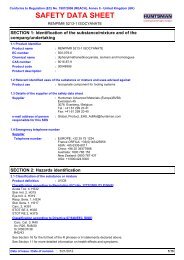You also want an ePaper? Increase the reach of your titles
YUMPU automatically turns print PDFs into web optimized ePapers that Google loves.
TECHNICAL BULLETIN<br />
PlatSil ®<br />
73-Series<br />
High Strength, Flexible, RTV Silicone Rubbers<br />
DESCRIPTION: PlatSil ® 73-Series RTV Silicone Rubbers are<br />
two-component, high strength, flexible, mold compounds. Molds<br />
made with 73-Series Silicones are excellent for casting many<br />
materials including polyester, epoxy and polyurethane resins. The<br />
73-Series Silicones are addition-cure, platinum-catalyzed systems,<br />
and offer advantages over tin-catalyzed systems in certain<br />
applications, because on curing they don’t shrink, they don’t produce<br />
alcohol (which can inhibit urethane castings), and their cure<br />
can be heat accelerated.<br />
MODEL PREPARATION: Seal porous models (i.e., wood or<br />
plaster) with wax, petroleum jelly, PVA, lacquer or paint to prevent<br />
penetration of the rubber into the pores of the material. The<br />
model and other surfaces that contact the liquid rubber should be<br />
coated lightly with Pol-Ease ® 2350 Release Agent or sprayed with<br />
Pol-Ease 2500 Release Agent. Pol-Ease 2350 is both a sealer and<br />
release agent and must be allowed to dry before applying liquid<br />
rubber. Pol-Ease 2500 is an aerosol spray and does not need to dry<br />
before applying liquid rubber. Do not use silicone-based release<br />
agents (i.e., Pol-Ease 2300) on surfaces that contact liquid<br />
PlatSil rubbers since inhibition and/or adhesion may occur. In<br />
addition, modeling clays containing sulfur may inhibit curing.<br />
PlatSil rubbers usually bond to cured silicone rubbers unless a<br />
parting agent is used. If there is any question about the compatibility<br />
between the rubber and the prepared model surface, a test<br />
cure should be made on an identical surface to determine that<br />
complete curing and good release are obtained.<br />
Porous models must be vented from beneath to prevent trapped<br />
air from forming bubbles in the rubber.<br />
MIXING & CURING: Weigh Part B and Part A in proper ratio<br />
into a clean mixing container. Accurate weighing is essential to<br />
obtain optimum physical properties from the cured rubber. Mix<br />
thoroughly, scraping sides and bottom of the container.<br />
FEATURES<br />
• Low viscosity for excellent reproduction of details<br />
and easy degassing.<br />
• Easy mix ratios -- can use with dispensing<br />
machines<br />
• Cure at room temperature or accelerate with heat<br />
• Easy release properties -- save on release agents<br />
• High tear strength -- fewer prematurely torn molds<br />
• Good chemical resistance for longer mold life<br />
• Low/zero shrinkage for better dimensional reproduction<br />
• Range of hardnesses from A15 to A60<br />
To ensure a bubble-free mold, it may be necessary to deaerate the<br />
liquid rubber under vacuum at 28-29 inches mercury. Plat-Sil 73-<br />
45 and 73-60 work best with vacuum. Other 73-Series rubbers<br />
(especially 73-15 and 73-25) do not necessarily need vacuuming<br />
since they are low viscosity. Evaluate the need for vacuum on a<br />
case-by-case basis. If vacuum is used, use a mixing container 3 to<br />
4 times larger than the volume of rubber and dearate until the<br />
mass of rubber rises and then collapses and continue for an additional<br />
2 minutes. Pour the rubber as soon as possible after mixing/vacuuming<br />
for best flow and air bubble release.<br />
If reinforcement of the rubber is needed (i.e., in thin blanket molds),<br />
place stretchy, open mesh nylon or dacron cloth into the uncured<br />
rubber. Be sure that the fabric is not too close to the mold surface<br />
or the weave of the cloth may show through to the face of the mold.<br />
PlatSil 73-Series rubbers cure faster at higher temperatures. To<br />
PHYSICAL PROPERTIES<br />
73-15 73-25 73-29 73-40 73-45 73-60<br />
Mix Ratio, By Weight 1A:1B 1A:1B 10A:100B 10A:100B 10A:100B 10A:100B<br />
Hardness, Shore A 15 25 30 40 45 60<br />
Pour Time (min) 20 15 45 45 60 45<br />
Demold Time (hr) @ 77 °F 4-5 4-5 16 16 16 16<br />
Color Translucent White Green White Yellow Green Blue<br />
Mixed Viscosity (cP) 2,500 6,000 15,000 15,000 35,000 40,000<br />
Specific Volume (in 3 /lb) 25.0 24.3 25.0 22.0 21.3 21.3<br />
Specific Gravity 1.10 1.14 1.10 1.26 1.30 1.30<br />
55 Hilton Street, Easton, PA 18042 • (800) 858-5990 or (610) 559-8620 • fax (610) 559-8626 • www.polytek.com • sales@polytek.com
each full hardness in the specified demold time, temperature<br />
should be above 77°F (25°C). At lower temperatures, more time<br />
may be needed to reach full hardness. Curing below 65°F (18°C)<br />
is not recommended.<br />
CURE INHIBITION: CAUTION! Contamination from amines,<br />
sulfur, tin compounds, polyester resins or some RTV silicone rubbers<br />
may inhibit surface cure. If in doubt, test compatibility by<br />
pouring a small quantity of catalyzed material on the surface to be<br />
reproduced, allow to cure and observe for proper cure and release.<br />
USING THE MOLD: No release agent is necessary for casting<br />
most materials in73-Series molds; but, for longer mold life with<br />
epoxy, polyurethane or polyester resins, a barrier coat or release<br />
agent (i.e., Pol-Ease 2300 or 2500) is recommended. Properly<br />
cured 73-Series molds last for years without deterioration. PlatSil<br />
73-Series molds are recommended for casting polyurethane foam,<br />
such as PolyFoam R-8. Refer to the PolyFoam Technical<br />
Bulletin for more information.<br />
ACCELERATING CURE SPEED: PlatSil 73X can be used to<br />
accelerate gel and cure times. Weigh and add 73X to Part B and<br />
mix. Then weigh and add Part A to the Part B/73X mixture and<br />
mix thoroughly. Pour over a prepared model as soon after mixing<br />
as possible. Demold when tack free. Experiment to determine the<br />
proper amount of 73X for the application. For 73-29, the addition<br />
of 1 part 73X per 100 parts of Part B decreases the gel time from<br />
45 min to to ~35 min. The addition of 2 parts decreases the gel<br />
time to ~30 min. The addition of 3 parts decreases the gel time to<br />
~25 min. Adding 73X softens the cured rubber slightly.<br />
Remember, heat accelerates the cure; low temperatures slow the<br />
cure.<br />
THICKENING FOR BRUSH ON: PlatSil 73-Series rubbers can<br />
be thickened with PlatThix liquid thickener or with Fumed Silica<br />
for brushing on a blanket mold.<br />
THINNING AND SOFTENING WITH SILICONE FLUID:<br />
The very low viscosity 50 cSt Poly-Sil ® Silicone Fluid can be<br />
added sparingly to the mixed rubber to thin the mix with some<br />
loss of strength, hardness and cure speed. If more than 10% fluid<br />
is added to the mix, then fluid might exude from the cured rubber.<br />
BARRIER COAT: A barrier coat is a fast drying, lacquer-like<br />
primer that can be sprayed into a silicone mold and allowed to dry<br />
prior to pouring liquid plastic. Upon removing the cured plastic<br />
casting from the mold, the barrier coat comes out on the plastic<br />
casting resulting in a primed part. Using a barrier coat can extend<br />
mold life.<br />
SAFETY: Before use, read product labels and Material Safety<br />
Data Sheets. Follow safety precautions and directions. Avoid contact<br />
with mucous membranes and eyes. Best method of cleanup is<br />
by wiping with paper towels and washing with waterless hand<br />
cleaner, then soap and water. If solvents must be used, denatured<br />
ethyl alcohol is best, but should be handled with respect for health<br />
and flammability hazards.<br />
STORAGE LIFE: At least six months in unopened containers<br />
stored at room temperature (60-90°F). Tightly reseal containers<br />
after opening.<br />
PACKAGING<br />
Unit Weight<br />
Product<br />
(lb)<br />
PlatSil ® 73-15 and 73-25 2.0<br />
Mix Ratio 1A:1B<br />
16.0<br />
80.0<br />
(By Weight)<br />
PlatSil ® 73-29, 73-40,<br />
73-45, and 73-60<br />
Mix Ratio 10A:100B<br />
(By Weight)<br />
* Applies to 73-29 and 73-40 only.<br />
1.0 lb<br />
9.0 lb<br />
44.0 lb<br />
495 lb*<br />
550<br />
ACCESSORIES<br />
Pol-Ease ® 2300 Release Agent<br />
12-oz aerosol can, case of 12 cans<br />
Pol-Ease ® 2350 Release Agent<br />
1 qt (1.5 lb), 5 gal (26 lb)<br />
Pol-Ease ® 2500 Release Agent<br />
12-oz aerosol can, case of 12 cans<br />
Poly PVA Solution<br />
1 qt (2 lb), 5 gal (35 lb)<br />
PlatThix<br />
For Thickening PlatSil Rubbers<br />
4 oz, 1 pt (1 lb)<br />
Silicone Fluid 50 cSt Grade<br />
For Thinning PlatSil Rubbers<br />
1 qt (2 lb), 1 gal (8 lb), 5 gal (40 lb)<br />
PlatSil ® 71/73X Accelerator<br />
4 oz, 1 pt (1 lb), 1 gal (8 lb)<br />
PlatSil ® 71R Retarder<br />
4 oz, 1 pt (1 lb), 1 gal (8 lb), 5 gal (40 lb)<br />
Barrier PF<br />
1 qt (1.5 lb), 5 gal (35 lb)<br />
Fumed Silica<br />
5 gal, 1 bag (10 lb)<br />
Part A (lb)<br />
1.0<br />
8.0<br />
40.0<br />
0.1<br />
0.9<br />
4.0<br />
45.0*<br />
50.0<br />
Part B (lb)<br />
1.0<br />
8.0<br />
40.0<br />
0.9<br />
8.1<br />
40.0<br />
450*<br />
500<br />
DISCLAIMER: The information in this bulletin and otherwise<br />
provided by Polytek ® is considered accurate. However, no warranty<br />
is expressed or implied regarding the accuracy of the data,<br />
the results to be obtained by the use thereof, or that any such use<br />
will not infringe any patent. Before using, the user shall determine<br />
the suitability of the product for the intended use and user<br />
assumes all risk and liability whatsoever in connection therewith.<br />
Apr. 27, 2010\platsil73-2010.qxp<br />
55 Hilton Street, Easton, PA 18042 • (800) 858-5990 or (610) 559-8620 • fax (610) 559-8626 • www.polytek.com • sales@polytek.com


